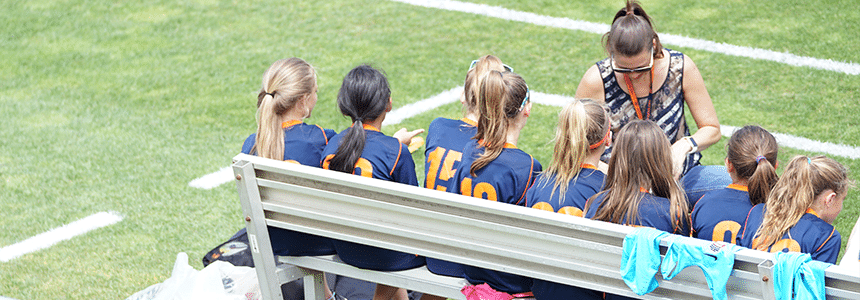
Towards a new identity for Europe’s most popular sport?
“Feminisation” is considered by many observers as high stakes for the development and renewal of football in Europe. This may announce a revolution in what is still considered by many as a male bastion and a catalyst for European identity. To what extent can we really say that women are the future of European football?
First of all it should be recalled that football has been played by women since ages. Indeed 2014 marks the 120th anniversary of the birth of the first women club in Europe, ie the British Ladies FC… ten years later in 1895 they played their first match at Crouch End. The vintage press report reveals the match was not entirely accepted by the establishment (“regarded by the football authorities as a ‘farce’”) but that some 10,000 spectators turned out to watch this novelty… Therefore let’s keep in mind and make it clear that women football is nothing small or new! However no one can deny that women are still trying to find their place in the typically masculine domain of sport. After all it was only in early 1971 that UEFA passed a motion (which became an official recommendation in November 1971) in favour of member countries taking control of women’s football. It is only from this perspective -ie knowing this background- that the question about the feminisation of football and its impact on the game can make sense.
Trying now to provide few hints as regards my original ask (ie “To what extent can we really say that women are the future of European football?”), I would like to explore the three dimension of this assertion.
THE POTENTIAL OF WOMEN AS FOOTBALL PLAYERS
Investing in women football undoubtedly represents a clear pathway for the strategic development of the game.
Women want to play the game and this is proven by observations on the ground and by data provided by national federations which clearly highlight an increasing number of women and girls playing football. In many European countries, it is even growing faster than its male counterpart and represents the fastest growing sector[1].
Not only do women represent a large (still under developed) pool of players… Women football is also a tremendous market. While it was confidential (or considered as such) few years ago, nowadays women football has truly become an appealing product for a growing audience[2] as highlighted by the investment of Eurosport to cover women football in France (see the advertisement) or the choice of ESPN to partner with the Football Association in order to get the broadcasting rights of the WSL.
Therefore it is not a surprise to witness many initiatives from football governing bodies to invest in the development of women football[3].
THE IMPACT AND POTENTIAL OF WOMEN AS FOOTBALL CONSUMER
In the recent years, a body of proofs has clearly shown that whether from the prism of grassroots participation or the prism of professional football, nurturing the increasing interest of women towards football is of utmost importance.
Women have shown a growing appetite for sport and football in the last decade and have become great consumers of sport content and sport activities. For example, in Germany there have been more women than men watching national football team’s games since the UEFA EURO 2008! The same trend is to be observed for supporters attending the game. FC Sankt Pauli (Hamburg, Germany) for example prides itself on having the largest number of female fans in all of German football and considered it as part of its cultural identity.
Not surprisingly women have therefore become a privileged target for the football sector. Indeed professional’s marketers clearly grasp the fact that women are nowadays the Decision maker in the family. Therefore convincing them about the beauty, joy and benefits of football is of utmost importance both for grassroots sport (to ensure children keep on practicing in clubs) and for the professional end side of the spectrum (to renew the stadia audience, this challenge proving to be of utmost importance in France with the enlargement of the stadia capacity ahead of the EURO2016, and to increase Merchandising sales).
Understanding the potential of women as “consumer” of football and nurturing this growing interest is for sure endemic of this trend labeled as the feminisation of football and which therefore goes far beyond than the development of women football.
WOMEN IN FOOTBALL IN LEADERSHIP POSITION
Last but not least, the feminisation of football refers to a political will and strategic vision to have more women sitting at higher position. The phenomenon is in fact nowadays supported from within the sector which has been urged by external pressure (society and political leaders) to move on.
At top decision-making level, some role models have emerged over the last few years. Steffi Jones, former German player, is now the new UEFA ambassador for Women’s Football and the Norwegian Karen Espelund has become the first women to be a UEFA Executive Committee member (since March 2011) and this is already worth a million in a still male-dominated bastion.
However, while we may have the feeling that football has already come a long way, there is still an evident lack of women in top-level positions. More needs to be done to change perspectives and increase opportunities. That’s what lead the UEFA to set a new project, the UEFA Women in Football Leadership Programme – a specific leadership scheme for women involved in UEFA member associations[4]. The long-term development programme will help individuals with a potential to become leaders as well as those already in some leadership positions to climb up the ladder of promotion through skills development.
Whether the programme will reach its objectives and be ambitious and innovative enough is by now impossible to say since it’s the very first step. However it is worth noticing that in that perspective, the feminisation of football is meant to be a fight against some clichés as well as a trend that should allow women leaders to get higher executive positions thanks to adequate skills therefore going further than a simple communication answer to some societal pressure.
PROJECTION…
One can therefore say that the feminisation of football is a fundamental shift. I would however not speak about a revolution. Indeed, I believe the world of sport –and football belongs to this special world- cannot live outside the real world in a parallel universe. The economic downturn and the change in the society have an impact on football and therefore the feminisation of football should be regarded and embraced for what it is: a natural and rational movement. Will this movement impact the European football identity? Of course it will but football lovers shall not be scared about it. European football has strong roots and its DNA cannot be changed, it just has to evolve to keep on growing. While at the moment Diana Pearce’s concept of the feminisation of poverty (describing a phenomenon in which women represent disproportionate percentages of the world’s poor) can be applied to the football sphere (since gender equity is far from being achieved yet), true is that the feminisation of football can in the end be the richness of the game.
Whether this foreseen change in European football can be a new catalyst for European identity, this is another –yet proper- question which should be the subject of another reflection.
Article published on the FREE (Football Research in an Enlarged Europe) project website in April 2013
[1] The FIFA Big Count surveys indicate that between 2000 and 2006 overall participation in football increased by 9% across FIFA’s 207 member associations, with male participation increasing by 8% and female participation increasing by 19%. As for the enlarged Europe covered by UEFA, the survey reported an overall increase of female participation. While in 2000, women and girls represented only 5,78% of the overall participants, in 2006 they were already representing 10,32% of the football players. Source: FIFA Big Count surveys, http://www.fifa.com/worldfootball/bigcount/index.html
[2] For example, a French national women team game (France-Wales, 4th April 2012, qualification for the EURO 2013) competed with two Champion’s League quarter final games in terms of tv ratings.
[3] Just to name few examples: “Le football des princesses” in France as a development plan to attract more girls to football clubs, the £6m investment of the Football Association (English Football Federation) into the Women’s Superleague (a new elite, summer semi-professional league for women’s football created in 2011) in order to encourage more females to take up the sport while making it more attractive, or the 2012 shift for the UEFA Champions’ League final which was for the first time organised in the same city for both women and men competitions (ie Munich)).
[4] Read more: UEFA’s women’s leadership drive
